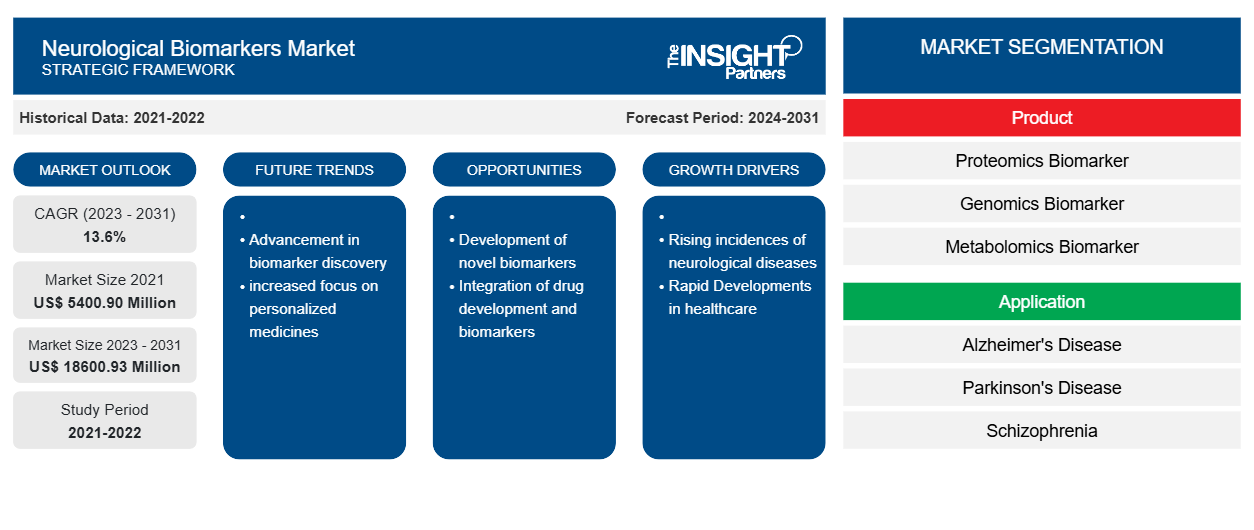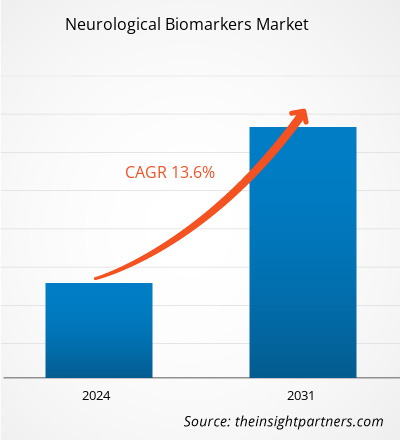The Neurological Biomarker Market size was estimated to be US$ 5400.90 million in 2021 and US$ XX million in 2023 and is expected to reach US$ 18600.93 million by 2031; it is estimated to record a CAGR of 13.6% in 2031. The market is driven by factors such as the rising prevalence of neurological diseases and the growing focus on neurological biomarkers research. However, concerns associated with the biomarkers will likely hinder market growth during the forecast period. Moreover, rapid developments in the overall healthcare sector are likely to remain key Neurological Biomarkers Market trends.
Neurological Biomarkers Market Analysis
Neurological diseases significantly burden health systems in terms of disease diagnosis, treatment, and management. Some of the major neurological disorders are epilepsy, Alzheimer’s disease, multiple sclerosis, spinal muscular atrophy (SMA), Duchenne muscular dystrophy, and others. The geriatric population is susceptible to neurological diseases. Neuropathy, Parkinson's disease, Alzheimer's disease, and dystonia are among the most common neurological disorders affecting older people. According to the National Institutes of Health (NIH), 8.5% of the world's population (i.e., around 617 million people) are 65 and above. According to the World Health Organization (WHO), neurological diseases contribute 6.3% to the global disease burden and are one of the leading causes of death worldwide. In addition, 13.2% of deaths in developed countries and 16.8% in low- and middle-income countries are reported due to neurological diseases. Rising cases of neurological disease in developed as well as emerging economies are driving the growth of the neurological biomarkers market.
Neurological Biomarkers Market Overview
Biomarkers are the molecules that indicate the presence of a disease. The biomarkers of neurological diseases were not that accessible in earlier days; however, advancements in technology have enabled tracking the brain's health condition by measuring the biomarkers. This helps in the earlier detection of a disease, is less invasive diagnostic enables faster drug development, and is expected to be an effective treatment.
Global neurological biomarkers market is segmented by region into North America, Europe, Asia Pacific, the Middle East & Africa, and South & Central America. In North America, the US is the largest market for neurological biomarkers. The neurological biomarkers market growth in the US is attributed to the market players adopting organic and inorganic strategies for market development. For instance, in May 2020, Quanterix Corporation, a company digitizing biomarkers analysis to advance the science of precision health, announced that it would expand its robust menu of ready-to-use Simoa kits to include tau phosphorylated at threonine 181 (p-tau181), a highly specific biomarkers for the study of Alzheimer’s disease pathology, in cerebral spinal fluid (CSF), serum and plasma. As per the Alzheimer’s Association, in 2020, an estimated 5.8 million Americans aged 65 or more are living with Alzheimer’s dementia, which is expected to reach 13.8 million by 2050. Thus, the growing prevalence of neurological diseases will likely favor the market's growth during the forecast period.
Customize This Report To Suit Your Requirement
You will get customization on any report - free of charge - including parts of this report, or country-level analysis, Excel Data pack, as well as avail great offers and discounts for start-ups & universities
Neurological Biomarkers Market: Strategic Insights

-
Get Top Key Market Trends of this report.This FREE sample will include data analysis, ranging from market trends to estimates and forecasts.
Neurological Biomarkers Market Drivers and Opportunities
Rapid Developments in Healthcare to Favor the Overall Market
Rapid developments in the healthcare and drug discovery sector are leading to the introduction of new therapeutic solutions for the treatment of neurological diseases. Authorities such as the World Health Organization, the National Institute of Neurological Disorders and Stroke, and the National Institutes of Health are taking constructive steps to encourage research activities and find a remedy for neurological disease treatment. The National Institute of Neurological Disorders and Stroke (NINDS) biomarkers program is focused on enhancing the quality and efficiency of neurotherapeutic clinical research and supports the biomarkers validation. The program promotes rigorous biomarker identification and validation by providing funds for research activities. Biomarkers across Neurodegenerative Diseases (BAND) is a program that aims to stimulate research analyses on Alzheimer’s disease (AD), Parkinson’s disease (PD), and other neurodegenerative diseases. The Alzheimer’s Association, Alzheimer’s Research UK (ARUK), The Michael J. Fox Foundation for Parkinson’s Research (MJFF), and the Weston Brain Institute (Weston) fund multiple awards under this program.
This need is likely to drive the global neurological biomarkers market during the forecast period.
Advances in Biomarker Discovery – An Opportunity of the Neurological Biomarkers Market
Biomarker discovery has been rising in recent years. For instance, in April 2021, two novel sleep biomarkers associated with neurodegenerative diseases (Parkinson’s disease and dementia) were discovered by a group of NIH-funded institutions using the Sleep Profiler EEG Sleep Monitor by Advanced Brain Monitoring, Inc. This discovery is not only critical for neurological diseases but the biomarker helps in brain-related understandings. Such advancements in the recent past are likely to generate attractive growth opportunities for the neurological biomarkers market.
Neurological Biomarkers Market Report Segmentation Analysis
Key segments that contributed to the derivation of the Neurological Biomarkers Market analysis are product and application.
- Based on product, is segmented into proteomics biomarker, genomics biomarker, metabolomics biomarker, imaging biomarker, and others. In 2023, the genomics biomarkers segment held the largest neurological biomarkers market share, and the same segment is expected to grow at the fastest rate during the forecast period. Genomics has made substantial progress towards personalized diagnostics and therapeutics based on individual genetic variations. Genomic biomarkers have proven their use in the identification of neurological diseases such as Parkinson’s disease, Alzheimer’s disease, Huntington’s disease, Autism, and others. The rising advent of personalized medicines and genetic profiling for diagnostics and therapeutic applications of neurological disorders is expected to augment the growth of the segment over the coming years.
- The application segment is segmented into Alzheimer’s disease, Parkinson's disease, schizophrenia, Huntington's disease, spinal muscular atrophy, and others. The Alzheimer’s disease segment held the highest share of the neurological biomarkers market in 2023, and the same segment is anticipated to witness growth at a significant rate from 2024 to 2031. Alzheimer’s disease refers to a progressive disorder that results in brain cells wasting away (degenerating) and eventually dying. As the disease develops, the patient suffers from severe memory impairment and inability to perform everyday tasks. The medications available at the current state may temporarily improve symptoms or slow the rate of decline. The increasing incidence of the disease is expected to account for the growth of the neurological biomarkers market over the coming years.
- Based on end users the market is segmented into pharmaceutical and biotechnology companies, clinical diagnostics, and research organizations. In 2023, the pharmaceutical and biotechnology companies segment held the largest market share, and the same segment is also expected to grow at the fastest rate in the coming years. Thus, the above-mentioned factors are responsible for the growth of the neurological biomarkers market size.
Neurological Biomarkers Market Share Analysis by Geography
The geographic scope of the Neurological Biomarkers Market report is mainly segmented into five regions: North America, Asia Pacific, Europe, the Middle East & Africa, and South America/South & Central America.
The Asia Pacific region is expected to be the fastest-growing region among all other regions. The growth of the market in the Asia Pacific region is expected to grow at a faster pace owing to factors such as increasing need for superior diagnostic and treatment solutions, growing prevalence of neurological diseases, and increasing focus on research and development activities. Additionally, developing healthcare infrastructure and increasing investments to boost research activities are projected to drive the Asia Pacific neurological biomarkers market during the forecast period.
Neurological Biomarkers Market Regional InsightsThe regional trends and factors influencing the Neurological Biomarkers Market throughout the forecast period have been thoroughly explained by the analysts at The Insight Partners. This section also discusses Neurological Biomarkers Market segments and geography across North America, Europe, Asia Pacific, Middle East and Africa, and South and Central America.
Neurological Biomarkers Market Report Scope
| Report Attribute | Details |
|---|---|
| Market size in 2021 | US$ 5400.90 Million |
| Market Size by 2031 | US$ 18600.93 Million |
| Global CAGR (2023 - 2031) | 13.6% |
| Historical Data | 2021-2022 |
| Forecast period | 2024-2031 |
| Segments Covered |
By Product
|
| Regions and Countries Covered |
North America
|
| Market leaders and key company profiles |
|
Neurological Biomarkers Market Players Density: Understanding Its Impact on Business Dynamics
The Neurological Biomarkers Market is growing rapidly, driven by increasing end-user demand due to factors such as evolving consumer preferences, technological advancements, and greater awareness of the product's benefits. As demand rises, businesses are expanding their offerings, innovating to meet consumer needs, and capitalizing on emerging trends, which further fuels market growth.

- Get the Neurological Biomarkers Market top key players overview
Neurological Biomarkers Market News and Recent Developments
The Neurological Biomarkers Market is evaluated by gathering qualitative and quantitative data post primary and secondary research, which includes important corporate publications, association data, and databases. The following is a list of developments in the market for neurological biomarkers and strategies:
- In April 2021, Quantrix Corp., announced a webinar with leading industry experts to discuss neurological advancements related to the ultra-sensitive quantification of pTau181, pTau217, pTau231, and other neurological biomarkers (Source: Quantrix Corp, Press Release, 2021)
Neurological Biomarkers Market Report Coverage and Deliverables
The “Neurological Biomarkers Market Size and Forecast (2021–2031)” report provides a detailed analysis of the market covering below areas:
- Market size and forecast at global, regional, and country levels for all the key market segments covered under the scope
- Market dynamics such as drivers, restraints, and key opportunities
- Key future trends
- Detailed PEST/Porter’s Five Forces and SWOT analysis
- Global and regional market analysis covering key market trends, major players, regulations, and recent market developments
- Industry landscape and competition analysis covering market concentration, heat map analysis, prominent players, and recent developments
- Detailed company profiles
- Historical Analysis (2 Years), Base Year, Forecast (7 Years) with CAGR
- PEST and SWOT Analysis
- Market Size Value / Volume - Global, Regional, Country
- Industry and Competitive Landscape
- Excel Dataset
Recent Reports
Related Reports
Testimonials
Reason to Buy
- Informed Decision-Making
- Understanding Market Dynamics
- Competitive Analysis
- Identifying Emerging Markets
- Customer Insights
- Market Forecasts
- Risk Mitigation
- Boosting Operational Efficiency
- Strategic Planning
- Investment Justification
- Tracking Industry Innovations
- Aligning with Regulatory Trends





















 Get Free Sample For
Get Free Sample For